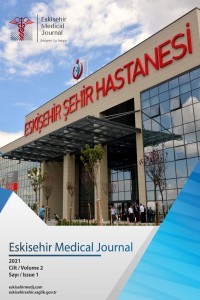Ağır Astımda Serum Periostin ve IL-13 Düzeylerinin Kan Eozinofilisini Belirlemedeki Etkinlikleri
Ağır astım, eozinofili, periostin, interlökin-13
Effectiveness of Serum Periostin and IL-13 Levels in Determining Blood Eosinophilia in Severe Asthma
Severe asthma, eosinophilia, periostin, interleukin-13,
___
- 1. Difficult-to-Treat and Severe Asthma Guide [Internet]. Global Initiative for Asthma - GINA. 2018 [cited 2021 Feb 8]. Available from: https://ginasthma.org/difficult-to-treat-and-severe-asthma-guide/
- 2. Chung KF, Wenzel SE, Brozek JL, Bush A, Castro M, Sterk PJ, et al. International ERS/ATS guidelines on definition, evaluation and treatment of severe asthma. Eur Respir J. 2014 Feb;43(2):343–73.
- 3. Ivanova JI, Bergman R, Birnbaum HG, Colice GL, Silverman RA, McLaurin K. Effect of asthma exacerbations on health care costs among asthmatic patients with moderate and severe persistent asthma. J Allergy Clin Immunol. 2012 May;129(5):1229–35.
- 4. Agache I. Severe asthma phenotypes and endotypes. Semin Immunol. 2019 Dec;46:101301.
- 5. Kuruvilla ME, Lee FE-H, Lee GB. Understanding Asthma Phenotypes, Endotypes, and Mechanisms of Disease. Clin Rev Allergy Immunol. 2019 Apr;56(2):219–33.
- 6. Lemière C, Ernst P, Olivenstein R, Yamauchi Y, Govindaraju K, Ludwig MS, et al. Airway inflammation assessed by invasive and noninvasive means in severe asthma: eosinophilic and noneosinophilic phenotypes. J Allergy Clin Immunol. 2006 Nov;118(5):1033–9.
- 7. Spector SL, Tan RA. Is a single blood eosinophil count a reliable marker for “eosinophilic asthma?” J Asthma. 2012 Oct;49(8):807–10.
- 8. Yilmaz I, Terl M. Asthma management: A new phenotype-based approach using presence of eosinophilia and allergy. Allergy. 2017 Oct;72(10):1587–9.
- 9. Kaur R, Chupp G. Phenotypes and endotypes of adult asthma: Moving toward precision medicine. J Allergy Clin Immunol. 2019 Jul;144(1):1–12.
- 10. Hershey GKK. IL-13 receptors and signaling pathways: an evolving web. J Allergy Clin Immunol. 2003 Apr;111(4):677–90; quiz 691.
- 11. Emson C, Pham T-H, Manetz S, Newbold P. Periostin and Dipeptidyl Peptidase-4: Potential Biomarkers of Interleukin 13 Pathway Activation in Asthma and Allergy. Immunol Allergy Clin North Am. 2018 Nov;38(4):611–28.
- 12. Horie S, Okubo Y, Hossain M, Sato E, Nomura H, Koyama S, et al. Interleukin-13 but not interleukin-4 prolongs eosinophil survival and induces eosinophil chemotaxis. Intern Med. 1997 Mar;36(3):179–85.
- 13. Agache I, Strasser DS, Pierlot GM, Farine H, Izuhara K, Akdis CA. Monitoring inflammatory heterogeneity with multiple biomarkers for multidimensional endotyping of asthma. J Allergy Clin Immunol. 2018 Jan;141(1):442–5.
- 14. Agache I, Strasser DS, Klenk A, Agache C, Farine H, Ciobanu C, et al. Serum IL-5 and IL-13 consistently serve as the best predictors for the blood eosinophilia phenotype in adult asthmatics. Allergy. 2016 Aug;71(8):1192–202.
- 15. Nabavi M, Arshi S, Bahrami A, Aryan Z, Bemanian MH, Esmaeilzadeh H, et al. Increased level of interleukin-13, but not interleukin-4 and interferon-γ in chronic rhinosinusitis with nasal polyps. Allergol Immunopathol (Madr). 2014 Oct;42(5):465–71.
- 16. James A, Janson C, Malinovschi A, Holweg C, Alving K, Ono J, et al. Serum periostin relates to type-2 inflammation and lung function in asthma: Data from the large population-based cohort Swedish GA(2)LEN. Allergy. 2017 Nov;72(11):1753–60.
- 17. Jia G, Erickson RW, Choy DF, Mosesova S, Wu LC, Solberg OD, et al. Periostin is a systemic biomarker of eosinophilic airway inflammation in asthmatic patients. J Allergy Clin Immunol. 2012 Sep;130(3):647-654.e10.
- ISSN: 2718-0948
- Yayın Aralığı: Yılda 3 Sayı
- Başlangıç: 2020
- Yayıncı: Eskişehir Şehir Hastanesi
COVID-19 Hastalarının Klinik ve Radyolojik Özellikleri: Eskişehir’de Tek Merkez Deneyimi
Pamir ÇERÇİ, Murat BAYAV, Muhittin AKARSU, Hakan AKGÜN, Arzu YURDASİPER, Kamil ÖZDEMİR, Bengü DOĞAN, İlknur AKÇAYIR, Fazilet YALÇIN, Zeynep IRMAK KAYA, Ebru ÖZDEN YILMAZ, Anıl UÇAN, Ayşe KUŞÇU, Nargüler AKSU, Yıldız AKBAY, Ahmet GÜNDÜZÖZ, Yonca YILMAZ ÜRÜN, Berrin YALINBAŞ, Serdar EFE, Fatih AYYILDI
Ali ÇONER, Emre ERTURK, Salih KILIÇ, Uğur TÜRK
İbrahim Çağrı KAYA, Merih ÖZBAYBURT, Mehmet ÖZGEYİK
Kübital Tünel Sendromuna Neden Olan Ulnar Schwannom: Olgu Sunumu
Turan KANDEMİR, Zeki Serdar ATAİZİ, Müge SEZER
Feokromositoma Cerrahisi; 3. Basamak Merkez Deneyimi
Dursun Burak ÖZDEMİR, Hayrettin DİZEN, Ahmet KARAYİĞİT, Bülent ÜNAL
Filiz KAYA, Şeyhmus KAYA, Engin ÖZAKIN, Ahmet Tuğrul ZEYTİN
Osman PİRHAN, Sinan AŞAR, Bahar PEHLİVAN, Önder KAYA, İbrahim Faruk AKTÜRK, Fethi KILIÇASLAN, Ercan AKŞİT
Dilek TOP KARTİ, Neslihan EŞKUT, Özge YILMAZ KÜSBECİ
Ağır Astımda Serum Periostin ve IL-13 Düzeylerinin Kan Eozinofilisini Belirlemedeki Etkinlikleri
